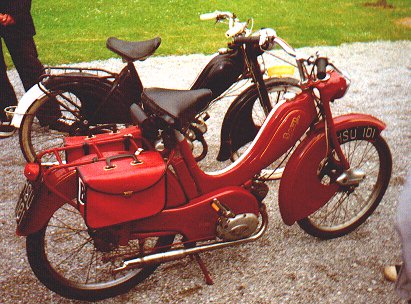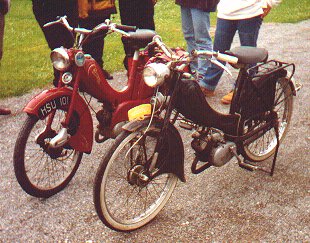 Go
to the Archive index
Go
to the Archive indexThe last of the Bowns came as a surprise. Within a year of the demise of Bown's operation in South Wales in 1954, which had produced the rather old-fashioned autocycles and motorcycles noted for their over-engineered duplex cradle frames, the firm was marketing a sinuous, modern and continental-looking moped featuring a pressed steel frame with integral tank. Gone were the Villiers engine units and in their place was a compact and relatively sophisticated Sachs 47cc engine with 2-speed twist-grip operated gear change, integral pedal cranks and back pedal brake. In fact all running gear was Sachs. The advertisements still claimed the bike was built in Britain at the Edmonton works of the Aberdale Cycle Company, but there must be some question as to whether, at the very least, the tooling for the pressed steel backbone and large valanced mudguards was not imported from Germany or Holland ‡ where such frames were used by several makers.
Bown was aiming at the market for powered bicycles and the November 1956 sales sheet, while retaining the old "Hand-Built for the Connoisseur" slogan, depicted a female rider. The moped's already fairly luxurious specification was uprated in 1957 on the de-luxe model to include plunger rear suspension, also made by Sachs, and a speedometer by VDO. The plungers are undamped but have an oil-filled slider to provide continuous total loss lubrication. A dipstick in each column is used to check the oil level.
Bown traditions were maintained (or were simply old stocks used up?) with tank transfers of the same size and design as on the motorcycles. This necessitated mounting the transfer at rather an extreme angle to make it fit within the small tank panels. Early models were grey with this tank panel in maroon but later more elaborate two-tone colour schemes were employed without the traditional dark red. Like the autocycles, as a touch of luxury, the bikes were extensively hand-lined.
How successful was Bown's final fling? The little bike certainly looks well with one-piece engine and chain guards on each side matching the style of the elaborate mudguards. Many of the bike's features: pressed steel construction, "step-thru" style, leading link front suspension, and extensive guarding of the rider from both road and engine dirt, have become standard features on modern lightweights. Performance was reasonable with a high mileage to the gallon (up to 200 being claimed) and good reliability. Commercially, however, the machine was less of an achievement. The company ceased manufacture in 1958 and unsold stocks were looking for purchasers for some time after that.
Part of the problem was undoubtedly cost. At the November 1955 show the Bown's price, including purchase tax, was more than that for comparable mopeds from Norman, Phillips, Berini and Zündapp and it was nearly a whacking thirteen pounds more than the excellent NSU Quickly (which would have been more than a week's wages for many prospective purchasers). By the following July the price had been reduced to bring it more in line with the first four named machines but this must have lowered the profit margin disproportionately since the cost of importing all the moving parts must have remained virtually the same.
There were other factors. Aberdale had been taken over by Tube Investments, the conglomerate who controlled Raleigh, and were thus now at the whim of corporate rationalisation and accountancy led strategic planning. Raleigh was producing its own mopeds and it may well have been company policy to discontinue the more expensive Bowns. Certainly anyone who has been close to an early Raleigh moped will tell you that it would have been an unwise dealer who let a customer try out the Bown first, whatever the difference in price...
As all small boys between 7 and 70 ask when they get near a motor cycle, how fast will it go? Well I can't give a definitive answer (but I think I have persuaded Rotherham's very own Worrall of the RAF to pilot the thing on one or two runs this year so you can always ask her for a race). I was unable to find the correct front sprocket with 12 teeth so the bike is too high geared. Its engine rebuild consisted of the fitting of a working coil and two new piston rings after the engine had been unseized using easing fluid, a length of wood and a mallet. The bike now has a low compression piston. Nevertheless it trots along very well on the level. As with all small-engined machines, hills are another matter. Bown's advertisement stated: "If you can ride a bicycle you can ride a Bown". In hilly country you get considerable practice at riding both.
The two gears are easy to use and quite positive for a cable change. On my (worn) machine, first has a slight tendency to jump under extreme load (ie: whenever I am riding). The combination of well sprung saddle and plungers makes for a comfortable ride. I have successfully completed three VMCC 100 milers on it without having the shape of my posterior noticeably changed. (I said changed, not improved. The jutting or overhanging buttock is an unfortunate family trait inherited from some stray gene of the genus homo neanderthalis. It would be very bad form for you to comment on it.)
There are still quite a few of these little bikes about. They have failed to attract the interest that the Bown autocycles and motor cycles have, so they should come fairly cheap. Be careful, however, to check over the frame and forks for cracks. The plunger models particularly are prone to this. Cracks are easily dealt with by a competent welder but unnoticed could prove an embarrassment in traffic.
First published - April 1994
‡ Footnote
Since this article was written, it has been established that the pressings used for the Bown were indeed also used on another Continental European moped. The photograph below was taken at Felleries in France on the date before the 1999 Rando Cyclos at Sars Poteries. There are quite a few differences beween the red Bown and its Dutch cousin—they have different engines for a start—but there is no doubt that the main frame pressings are identical.

